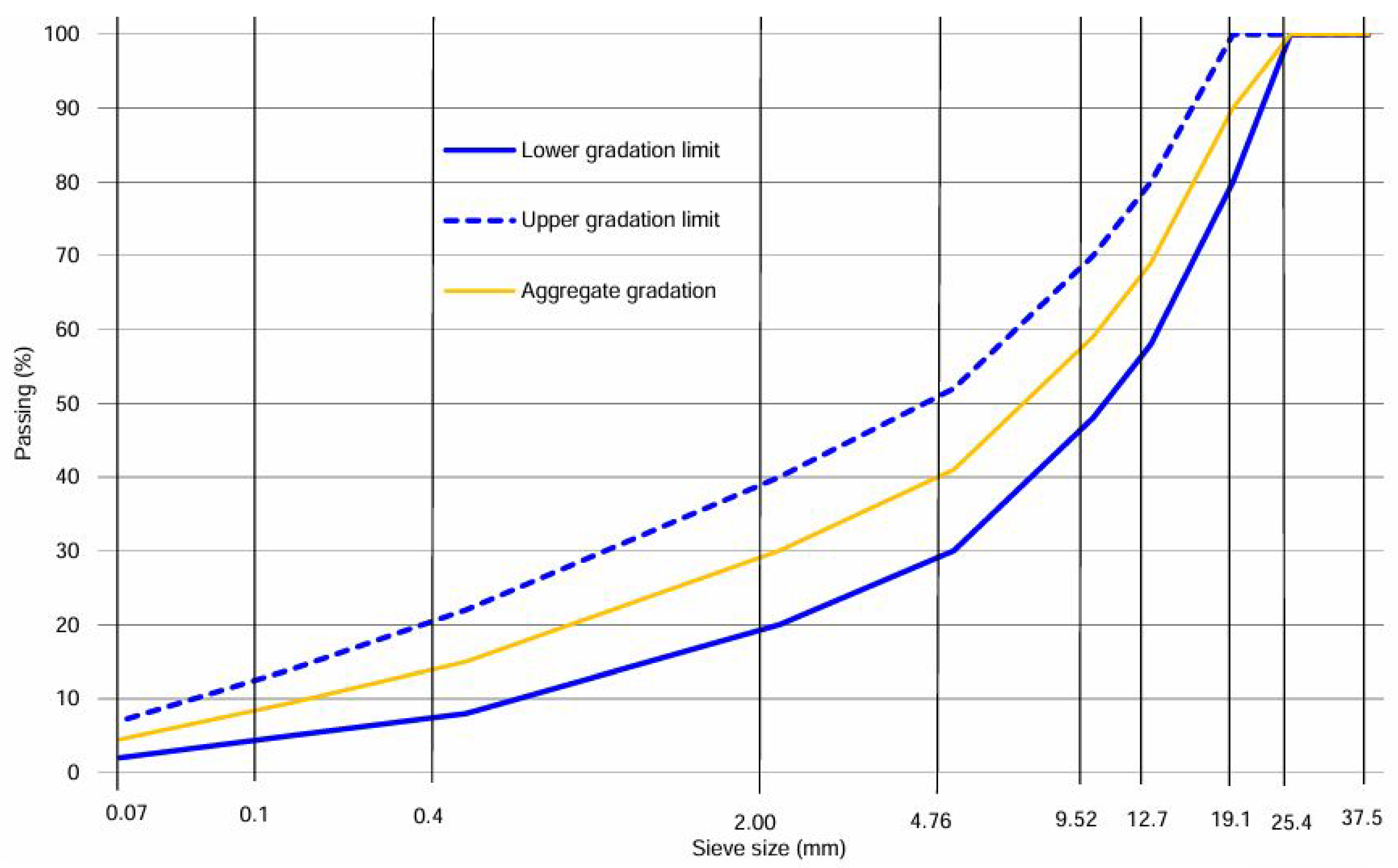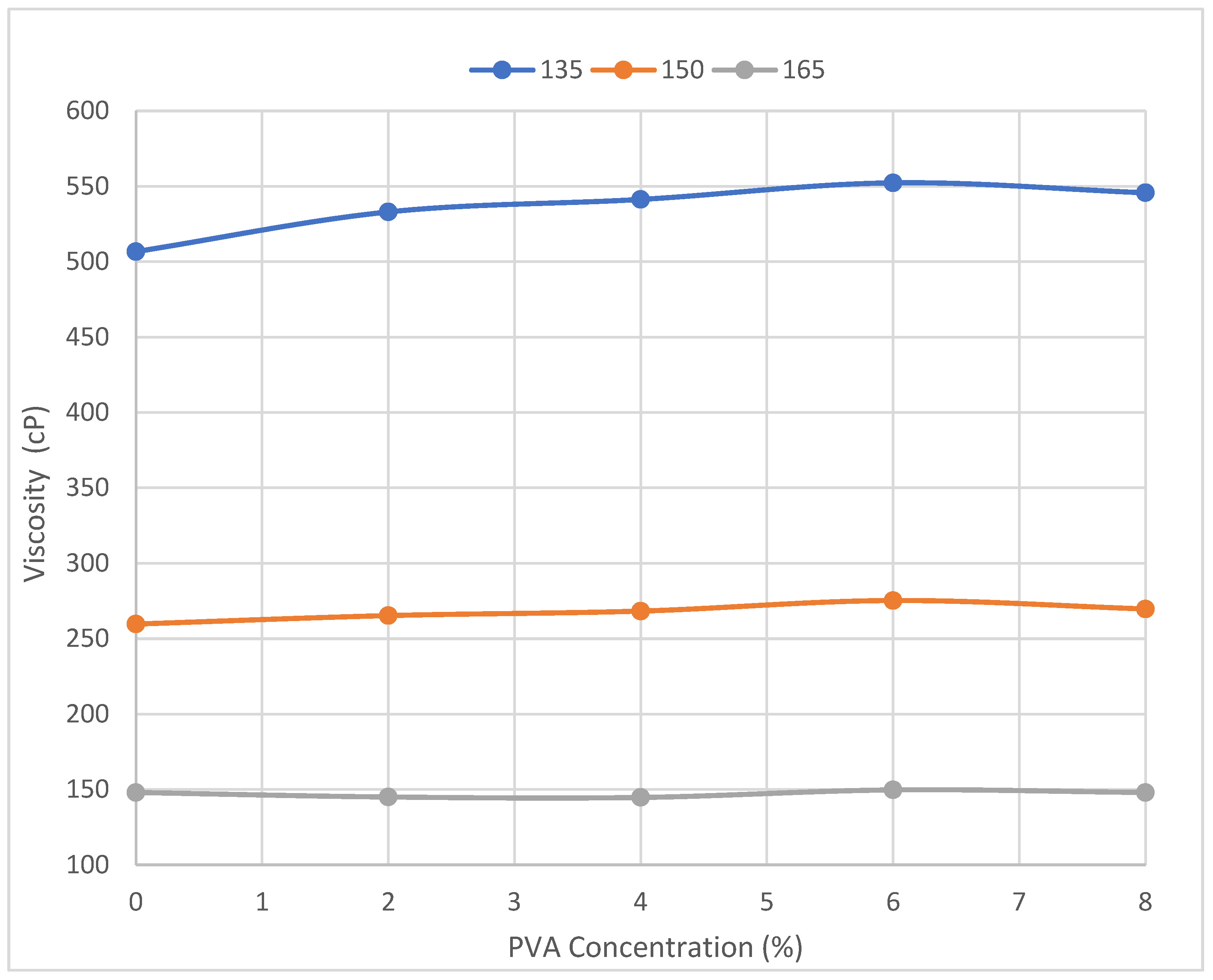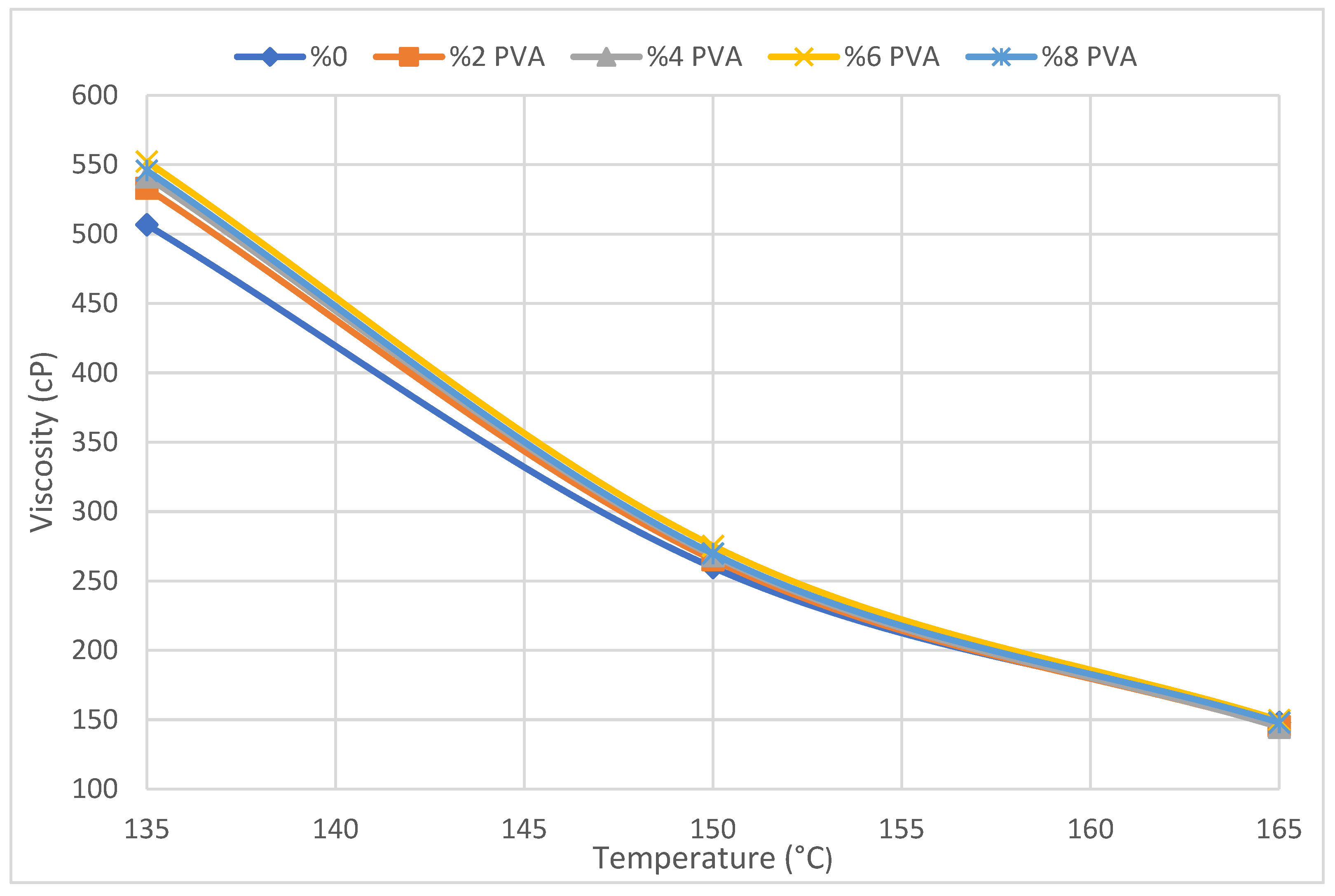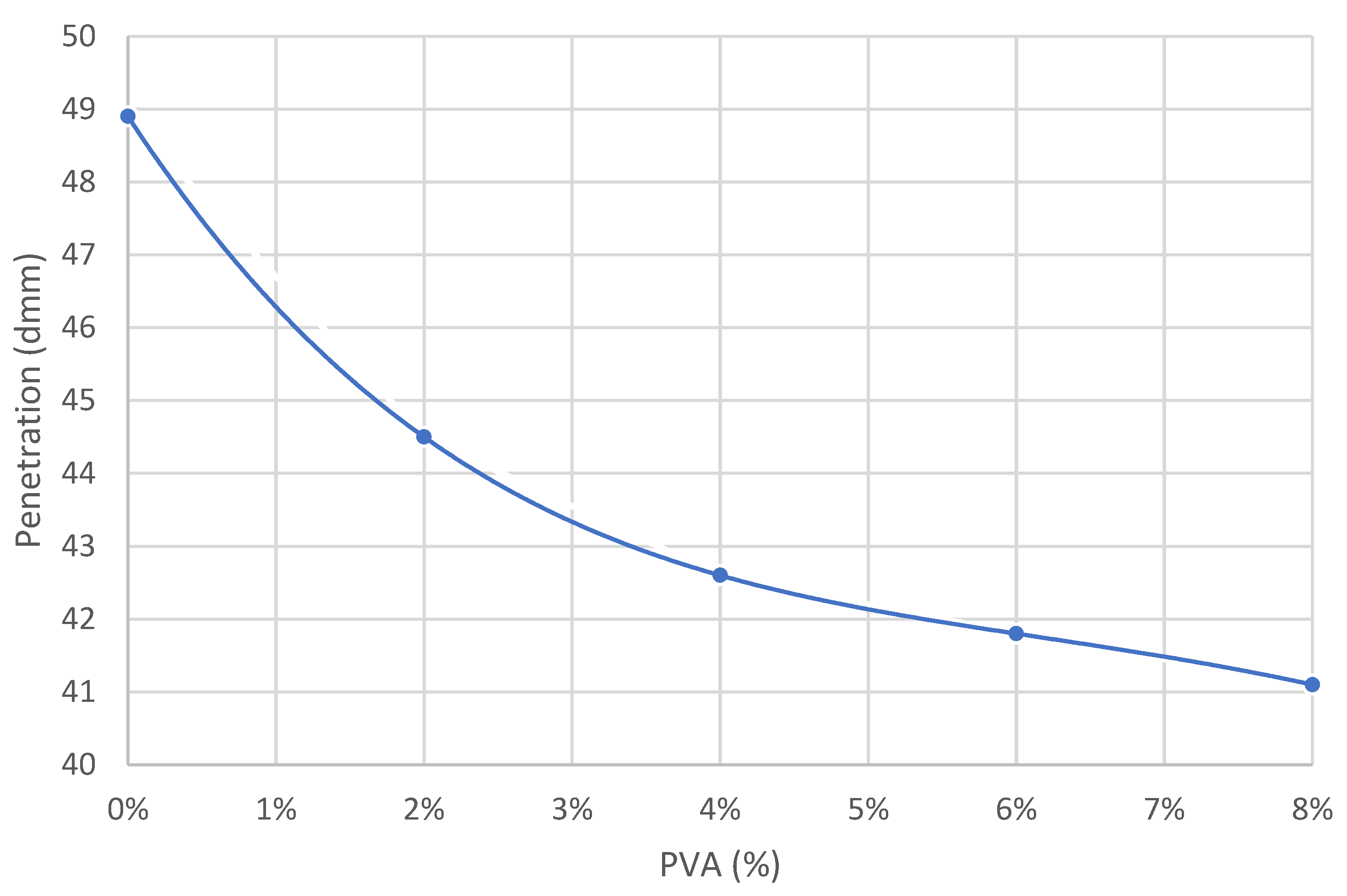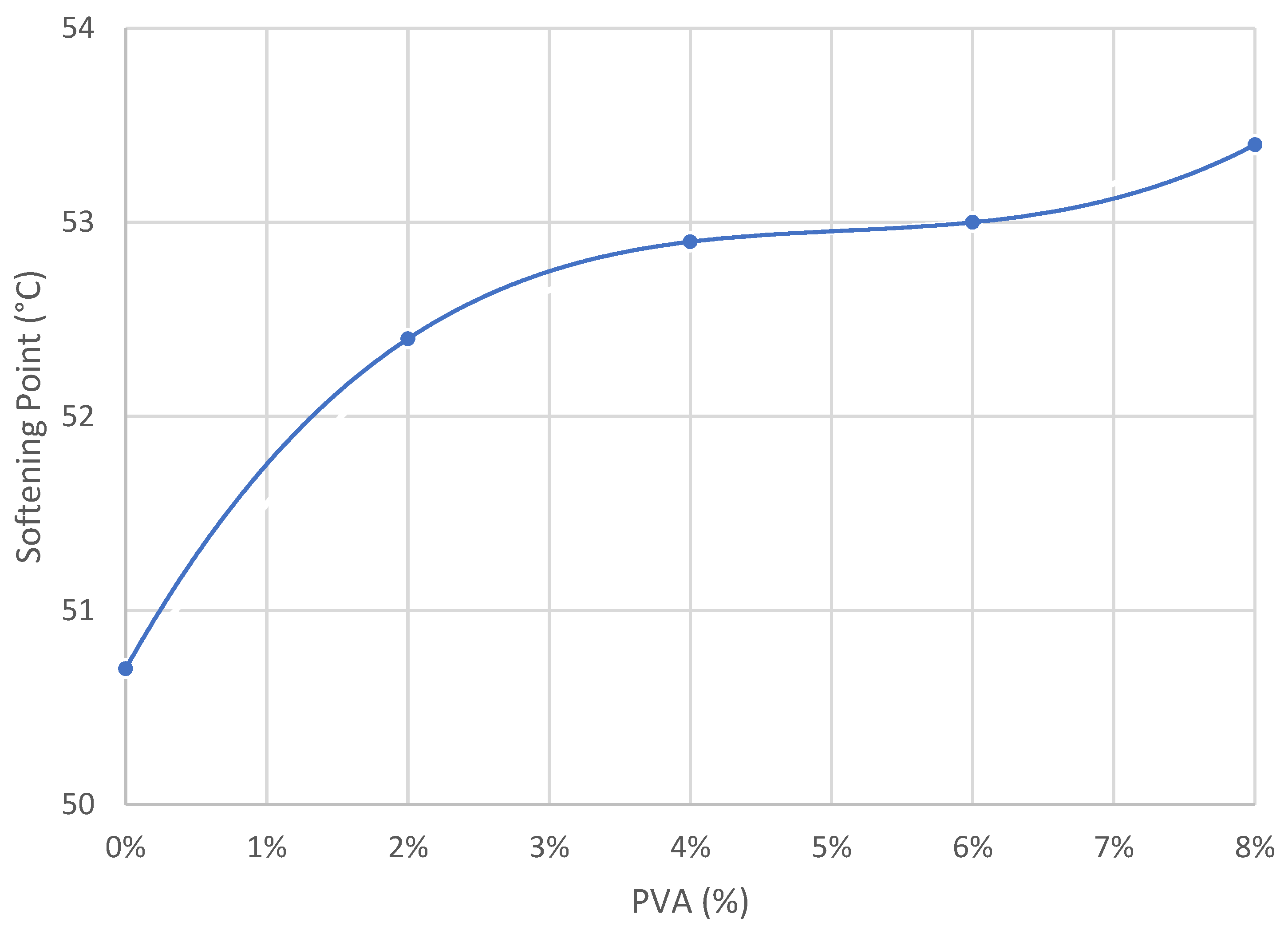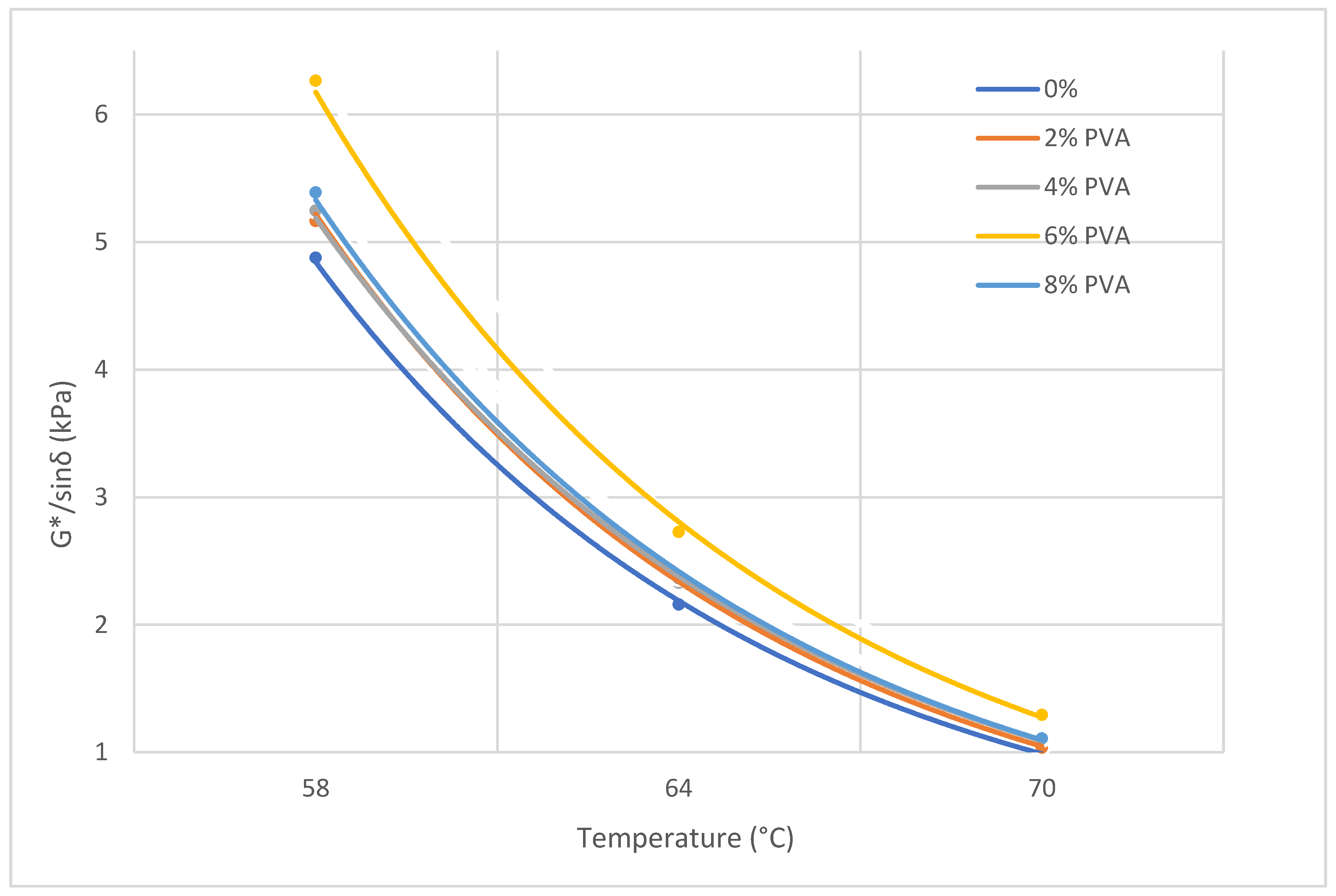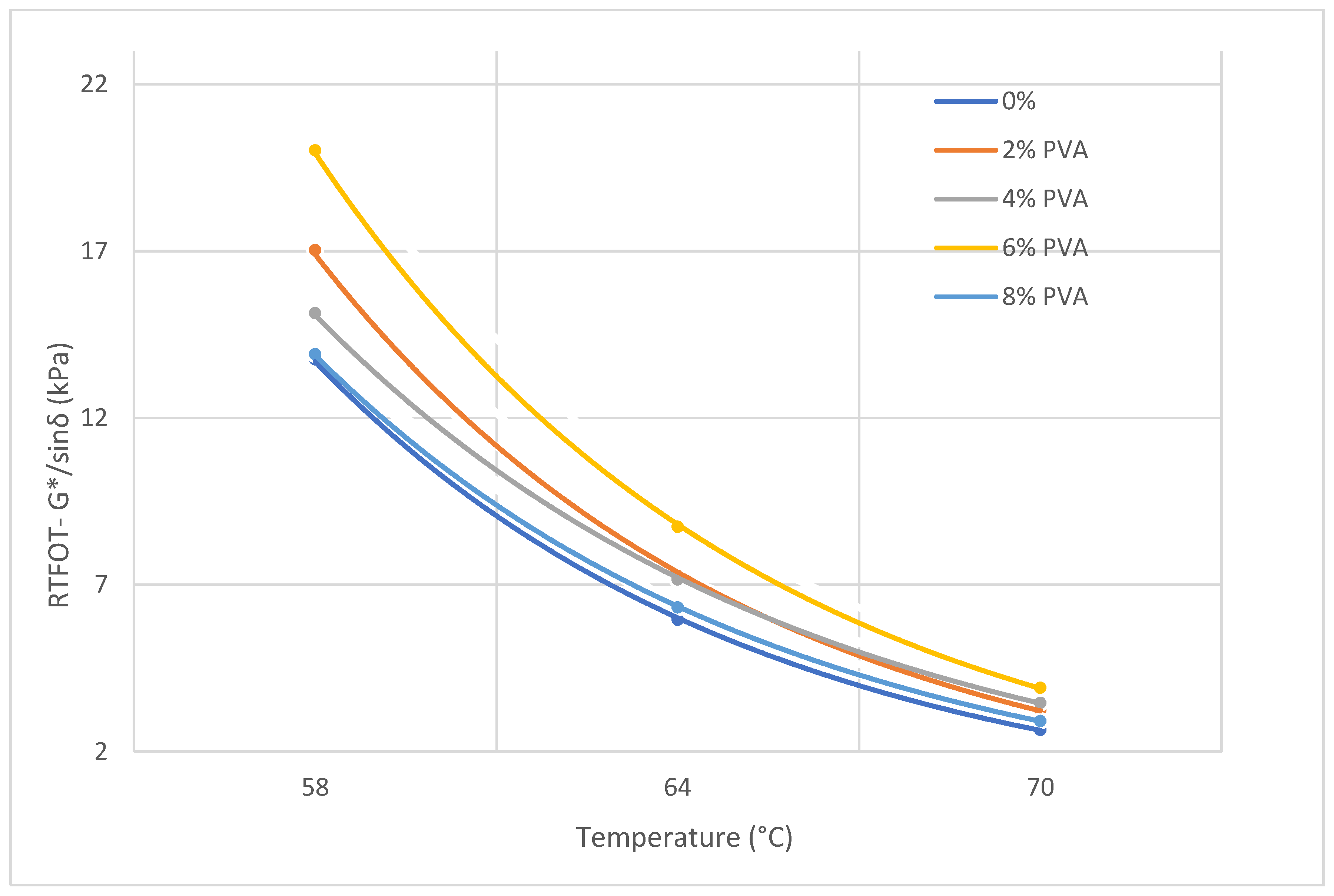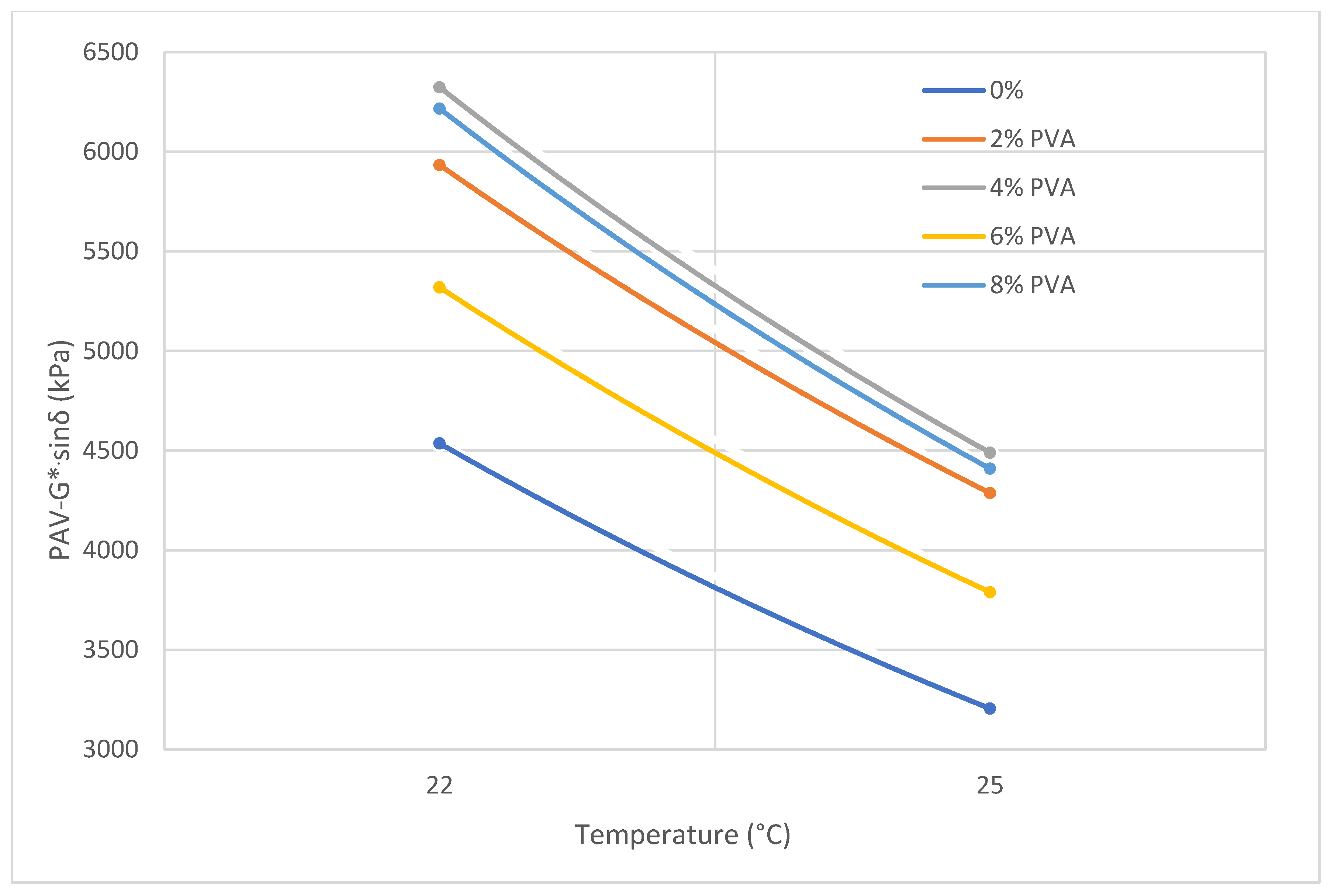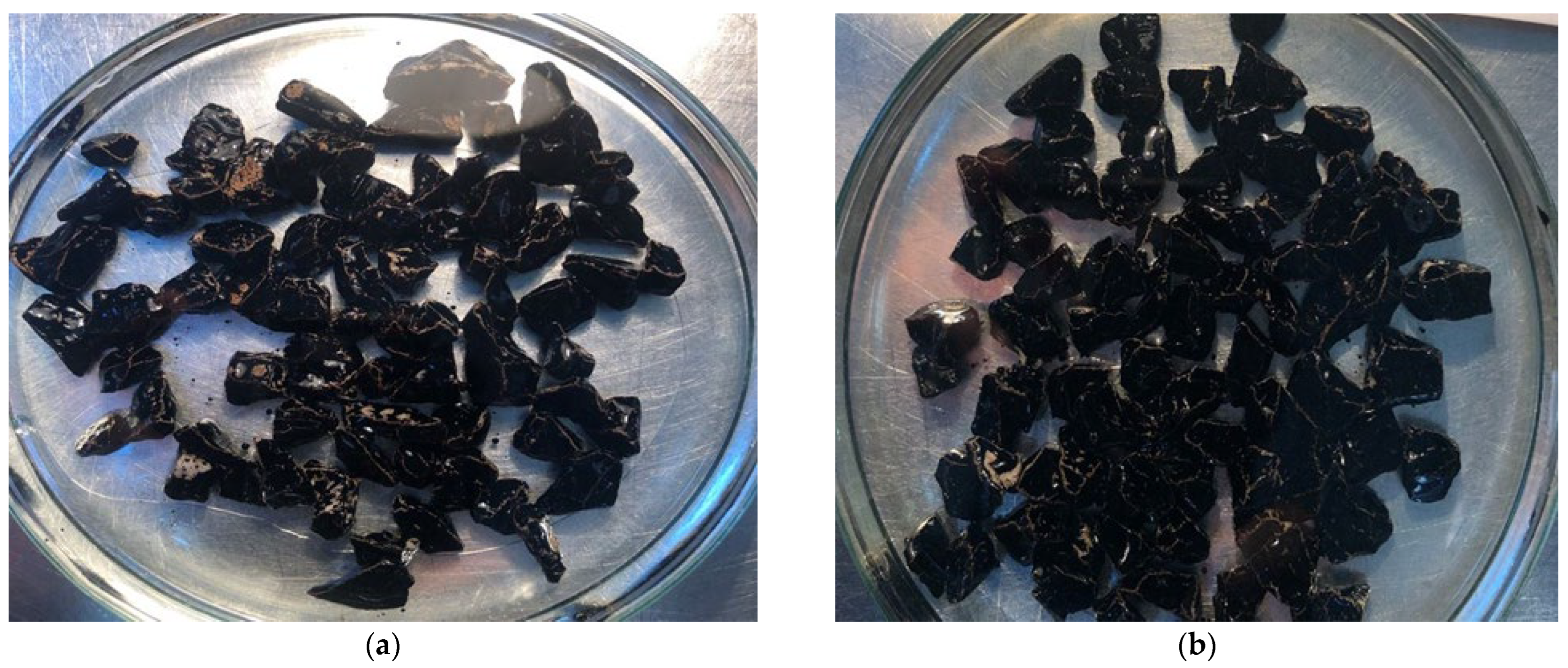1. Introduction
Bituminous binder is a composite material obtained as a residue from petroleum refineries, consisting of approximately 95 percent hydrocarbons by weight. However, the chemical compositions of bituminous binders cannot be precisely defined due to its complexity and variations based on the source of the crude oil and refining process [
1,
2].
Bitumen is widely used as a paving material for highways when it is combined with mineral aggregates. Bituminous mixtures are used in 85% of road pavements worldwide [
3,
4]. While the proportion of bitumen in comparison to aggregate is minimal, its characteristics have a substantial impact on the performance of highways. The rapid increase in traffic volume, the growth in freight transportation and the impact of environmental factors lead to deformations in asphalt pavements, resulting in a decline in asphalt binder performance [
5,
6]. For this reason, in order to increase the long-term durability of asphalt pavements and reduce maintenance costs, binder performance has been improved through various additives and modification methods. Among all the methods, polymer bitumen modification is the most commonly used method in studies on improving bitumen. Research has demonstrated that incorporating polymers—composed of repetitive molecular units—into the bitumen positively impacts its overall performance [
7]. Pavement with polymer modification has enhanced resilience to rutting and thermal cracking, as well as reduced fatigue damage, stripping and temperature susceptibility [
1,
7,
8].
The rheological behavior of bitumen can change from viscous to elastic depending on loading time and temperature. Bituminous mixtures must remain flexible at low service temperatures to prevent cracking and sufficiently stiff at high service temperatures to resist rutting [
9,
10,
11]. Therefore, polymer modification requires that the asphalt is not too viscous at high service temperatures to lead to permanent deformation, or too fragile to cause cracks at low service temperature [
12]. As a result of the studies, it has been shown that the performance potential of polymer-modified bitumen has increased and its weaknesses have decreased. In addition, depending on the development of asphalt pavements, layer thicknesses can also be reduced [
13,
14]. This is a situation wherein bitumen modification will make significant contributions to the sustainability and long-term service capacity of pavements.
Commonly used polymers for bitumen modification include polyethylene (PE), polyethylene terephthalate (PET), polypropylene (PP), polyurethane (PU), styrene butadiene styrene (SBS), ethylene vinyl acetate (EVA) and others [
1,
15,
16]. The wastes produced from polypropylene (PP) and polyethylene (PE) provide significant cost benefits in the modification procedure. However, both polymers are non-polar and have limited compatibility with asphalt [
5,
15]. In recent years, there has been significant studies conducted on PET and PU. However, their ability to avoid cracks has not been reliably ensured [
17]. The search for modifiers with a two-phase molecular structure increased due to the desire for improved characteristics of bitumen at both high and low temperatures. As a result, the SBS copolymer became known as a highly popular asphalt modifier. However, some studies discovered that the molecular structure of SBS contains unsaturated double bonds that are susceptible to breaking and oxidizing when exposed to UV radiation and high temperature [
18,
19]. This results in a loss of asphalt performance. Montmorillonite is utilized to enhance the anti-aging characteristics of SBS due to this reason. But the high expenses prevent the widespread use of these procedures. For EVA polymer modification, although it improves some properties of bitumen, there are still some problems that limit its application. One of these limitations is that EVA cannot improve the elastic recovery of bitumen much due to its plastomer nature [
20]. On the other hand, the effects of bitumen modification on aging have not yet been fully established. Studies aimed at improving the properties of bitumen often neglect the effects of polymer modification on aging. In particular, the temperatures reached during polymer modification and the mixing process have negative effects on the aging of bitumen [
21]. For the reasons mentioned above, there are still substantial gaps that need to be addressed in the development of bitumen modification.
Polyvinyl acetate (PVA) is a synthetic polymer produced by polymerizing vinyl acetate monomer. It is characterized by its versatility, adhesive properties and ease of production. As a result, it has become a widely used material in various industries such as construction, packaging and textiles. The chemical structure of PVA consists of repeating vinyl acetate units, which contribute to its distinct physical and chemical properties, such as flexibility, water resistance and compatibility with other materials [
22,
23]. In a study wherein bituminous cold mixtures were modified with PVA emulsion, it was shown that the compressive strength of the modified samples increased by 31%. It was thought that the thermoplastic structure and adhesive properties of the PVA emulsion caused this increase [
24]. In another study, soil samples were prepared by mixing PVA polymer with silt type soil as a binder. It was observed that the strength values obtained from static load tests of soil samples with PVA added were significantly improved [
25]. In a different study, the performance of bitumen and bituminous mixtures was evaluated by mixing basalt fibers with polyvinyl acetate emulsion. The results obtained showed that the high temperature deformation resistance, low temperature crack resistance and fatigue resistance of the basalt fiber bituminous mixture coated with PVA emulsion were significantly improved compared to the pure bituminous mixture [
26].
Compared to commonly used polymer additives such as SBS and EVA, the ability of polyvinyl acetate to integrate into bitumen at lower mixing temperatures and provide a homogeneous distribution offers a significant advantage in terms of both reducing energy consumption and minimizing the effects of short-term aging. In addition to its properties such as ease of production, water resistance and flexibility, another important advantage of PVA is its superior adhesive property, which can strengthen the bond between aggregate and bitumen [
22]. However, despite significantly improving the high and low temperature performance of bitumen, SBS has some drawbacks, such as relatively high cost, low resistance to aging and compatibility issues with certain bitumens. On the other hand, despite its favorable properties, EVA also has disadvantages such as low elastic recovery, insufficient adhesion and compatibility issues with bitumen [
1,
5]. On the other hand, compared to recycled polymers, although PVA does not provide a direct environmental contribution, its potential benefits, such as enhancing durability and extending the lifespan of pavements, can indirectly contribute to sustainability by reducing maintenance frequency and material consumption.
Moreover, although extensive research has been conducted on many polymer additives, primarily SBS and EVA, studies on PVA remain quite limited. This study aims to systematically evaluate the performance characteristics of bitumen and bituminous mixtures modified with PVA using both conventional and Superpave test methods. The findings obtained will make significant contributions to expanding the existing body of knowledge on alternative polymer additives.
The purpose of this study was to investigate the novel effects of PVA on bitumen and bituminous mixtures using both conventional tests, such as penetration, softening point, force-ductility, elastic recovery, Marshall and Nicholson stripping tests; and Superpave tests, including rotational viscosity (RV), rolling thin film oven test (RTFOT), pressure ageing vessel (PAV), dynamic shear rheometer (DSR) and bending beam rheometer (BBR). In this study, it was aimed to improve the performance of PVA additive by taking into account the modification process’s low temperature and mixing time. PVA was added to bitumen at 150 °C temperature and 20 min mixing time as a result of various tests, considering the aging effects of modification temperature and time. PVA was added to bitumen at 2%, 4%, 6% and 8% by mass and, as a result of bitumen tests, the PVA ratio to be used in modification for mixture tests was determined as 6%.
2. Materials and Methods
In this research, conventional 50/70 bitumen was used as the reference bitumen and designated as 0%. Mixtures containing 2%, 4%, 6% and 8% PVA additives were labeled as 2% PVA, 4% PVA, 6% PVA and 8% PVA, respectively. The experimental program process is presented in
Figure 1.
2.1. Bitumen
In this study, 50/70 penetration grade bitumen was used and its physical properties are presented in
Table 1. Bitumen was supplied by the Turkish Petroleum Refinery Corporation (Turkey-Kırıkkale Refinery, Kırıkkale, Turkey).
2.2. Aggregate
Bituminous mixtures were prepared using limestone aggregate. The aggregate was obtained from the Gümerdiğin quarry in Çankırı province. The binder course gradation limits specified in the Turkish State Highway Technical Specification were used for the aggregate gradation of the bituminous mixtures. The aggregate gradation and specification limits of the aggregate used in the Marshall stability tests are shown in
Figure 2. The physical properties of the aggregate are presented in
Table 2.
2.3. Additive Material
In this study, polyvinyl acetate (PVA), a white thermoplastic substance obtained through the polymerization of vinyl acetate, was used to modify the bitumen. Polyvinyl acetate, a viscous liquid with excellent binding properties, is commonly referred to as “PVA” or “PVAC”. The properties of the PVA polymer used in this study are presented in
Table 3.
2.4. Preparation of the Modified Bitumens
Modified bitumens were prepared by adding PVA polymer to the bitumen in four different proportions: 2%, 4%, 6% and 8% by weight. To determine the optimum mixing temperature and time, two different temperatures (120 °C and 150 °C) and three different mixing times (10 min, 20 min and 30 min) were evaluated. Then, bitumen samples modified with 3% PVA were mixed using a modified bitumen mixer at 1300 rpm under the following conditions: 120 °C—10 min, 120 °C—20 min, 120 °C—30 min, 150 °C—10 min, 150 °C—20 min and 150 °C—30 min. the modified bitumen specimens were analyzed with viscosity test at 135 °C. The viscosity test findings indicated that the optimal mixing temperature and time for achieving the maximum viscosity were 150 °C and 20 min. To minimize aging effects caused by mixing, temperatures over 150 °C and mixing durations exceeding 30 min were not considered. The bitumen was heated to 150 °C in a metal container. PVA was added in the specified proportions and mixed in an oil bath preheated to 150 °C. The mixing process was conducted at 150 °C for 20 min using a Silverson mechanical modified bitumen mixer at a speed of 1300 rpm.
2.5. Methods
In this study, the effect of PVA on bitumen and bituminous mixture properties was evaluated by conducting experiments including conventional and Superpave test methods. Within the scope of these experiments, rotational viscosity, penetration, softening point, flash point, RTFO, PAV, DSR, BBR, forced ductility, elastic recovery, Nicholson stripping and Marshall tests were applied.
The rotational viscosity tests for the original and modified bitumen were performed at 135 °C, 150 °C and 165 °C using a Brookfield DV-III rheometer in accordance with ASTM D 4402. The viscosity tests were performed to measure the effect of the additive on the flow characteristics of the asphalt. Considering the measurement geometry and rotation speed based on previous studies, spindle number 27 was selected, and the rotation speed was set to 20 rpm. During the experiment, the spindle immersed in the bitumen began to rotate, and the resistance of the bitumen to this rotational motion was used to determine the viscosity of the material. Three samples were tested for each viscosity measurement and their average value was calculated.
Penetration, softening point and flash point tests were performed according to EN1426, EN1427 and EN ISO 2592, respectively [
31,
32,
33]. During the penetration test, a standard load of 100 g was immersed in the bitumen at 25 °C for 5 s and the distance at which the penetration needle sank into the bitumen was measured in 0.1 mm. For each penetration value, three measurements were recorded and the mean value was calculated. Since the penetration value is inversely proportional to consistency, an increase in the penetration value indicates that the bitumen is softening. In the softening point experiment, the change in the sensitivity of bitumen to temperature with the addition of PVA was examined. The test was conducted by heating a bitumen sample placed inside a standard ring with a standard ball on it, placed in a water bath, at a certain constant speed. The temperature at which the bitumen sample softens as a result of heating and touches the base is determined as the softening point. Each measurement is obtained from the average of two samples. The softening point is an important component in the long-term deformation of bituminous pavement. Pavements with a binder having a high softening point are less prone to deterioration due to rutting [
34]. The flash point test was also conducted to determine the flash and fire points of bitumen after the addition of additives. The Cleveland open cup method was used in this test. One sample was used for each measurement. This test is conducted to determine the temperature at which bitumen can be safely heated without causing any danger.
The Rolling Thin-Film Oven (RTFO) (UTEST, Ankara, Turkey) and Pressure Aging Vessel (PAV) (ATS, Butler, PA, USA) tests simulate short-term and long-term aging of bitumen in a laboratory environment, respectively. The tests were conducted in accordance with the EN 12607-1 and EN 14769 standards [
35,
36]. The RTFOT test is conducted in an oven equipped with a carrier that can hold eight sample bottles rotating around their own axis. Each bottle is filled with 35 g of bitumen, and as the carrier rotates, bringing each bottle to the lowest position, an air blower sequentially injects air into the bottles. The samples are aged at a temperature of 163 °C for a duration of 75 min. The Pressure Aging Vessel (PAV) test is used to determine the long-term hardening (aging) effects that bituminous binders may experience throughout the service life of pavement. In this test, bituminous binders previously subjected to the RTFOT test are used. Then, 50 g of aged bitumen is poured into PAV containers and spread evenly. The containers placed into pressure vessel are kept at 2.1 Mpa pressure at 100 °C for 20 h. These samples obtained after the experiment are then placed in the sample storage cabinet to be subjected to DSR and BBR tests.
In this study, the force ductility test, conducted according to the EN 13589 standard, aimed to determine the tensile properties of the original and polymer-modified bitumen [
37]. Additionally, the elastic recovery test, conducted according to the EN 13398 standard, was used to determine the elastic recovery of modified bituminous binders using a ductilometer [
38]. The force ductility test is performed to determine the cohesion strength and elongation properties of bituminous binders at low temperatures. This test determines how much bitumen can elongate at a certain temperature and how much force is applied during this elongation. In the force-ductility test, the sample is subjected to elongation at the test temperature. The ductility device is designed to pull the sample at a specific speed while measuring the applied force. During the elongation process, the temperature is maintained at constant 25 °C, and the sample is stretched at a speed of 50 mm/min until it reaches an elongation of 1333% (400 mm). The elongation at the moment the sample breaks is measured. The ductility value is defined as the elongation at the breaking point and is expressed in centimeters. Three samples were tested for each measurement. Additionally, the device generates a force–elongation curve, which represents the relationship between the applied force and the elongation during the stretching process. The area under the curve indicates the deformation energy. The elastic recovery test is conducted to measure the elastic properties of bituminous binders, specifically their ability to return to their original shape after deformation. This test is performed using the same apparatus as the force-ductility test (ductilometer). The experiment is carried out in a water bath at a constant temperature of 25 °C. The ductility device is operated, and the sample is stretched to a length of 200 mm at a speed of 50 mm/min. Once the desired elongation is reached, the sample is cut in the middle. After the cutting process, a waiting period of 30 min is allowed for the sample to recover. At the end of the waiting period, the distance between the ends of the two pieces is measured [
1,
7].
Compared to conventional testing methods, DSR is a more advanced technique applied to evaluate the performance of bituminous materials in terms of their rheological properties. In this study, rheological measurements of the sample were carried out using a rheometer (Netzsch, Selb, Germany). The complex shear modulus (G*) and phase angle (δ) of the asphalt samples were determined by DSR experiments conducted at temperatures of 58 °C, 64 °C and 70 °C. These tests were conducted in accordance with EN 14770 standards [
39]. The asphalt sample was placed between two circular plates. The bottom plate was rigid. The top plate was oscillated at a frequency of 10 rad/s to apply a shearing force on the sample. The rheometer was used to measure the highest applied stress, which caused maximum strain, and the time gap between them. The values of G* and δ were later computed using DSR software. The obtained complex shear modulus (G*) and phase angle (δ) values were used as the main parameters to predict rutting and fatigue cracking in pavement. To achieve high resistance against rutting, the bitumen must be sufficiently rigid while also having the flexibility to recover its original shape once load is removed. For these reasons, a high value of the elastic parameter, G*/sin δ is desirable. On the other hand, to minimize the formation of fatigue cracks in the pavement, material is expected to be elastic enough to avoid excessive rigidity that could lead to cracking. For this purpose, the viscous component of the complex shear modulus (G* · sin δ) should be kept low [
34].
The bending beam rheometer (BBR) (Cannon Ins., Melville, PA, USA) test is used to measure the elastic and viscous behavior of bituminous pavements at low temperatures. The test involves applying a constant load to a bituminous binder sample prepared in the form of a small beam at a specific temperature to determine its creep and deflection properties. With the BBR test, creep stiffness (S) and creep ratio (m) of bitumen samples at low temperatures were examined. BBR test was performed at −12 °C and −18 °C using the BBR test device according to EN 14771 [
40]. Samples prepared from bitumens aged with RTFOT and PAV were subjected to testing. Two samples were tested for each measurement. During the test, a load of 980 mN was applied, and the dimensions of the test sample were 125 mm × 12.5 mm× 6.25 mm. The deformation occurring at the center of the beam during the 240 s test period was measured at various intervals using the device, and the creep stiffness (S) and creep rate (m) were calculated [
34,
41].
Additionally, the effect of PVA on bituminous mixtures was evaluated using Marshall and Nicholson stripping tests. Marshall stability and flow test were applied according to ASTM 6927 [
42]. This test is applied to determine the load carrying capacity (stability) and deformation properties (flow) of hot mixed asphalts. It is especially used for mixture design and performance evaluation. Stability is defined in the standard as the maximum resistance to deformation, while flow is described as the vertical deformation occurring in the specimen at the point of maximum load. The optimum bitumen content for use in the bituminous mixture is determined by evaluating the physical properties, stability and flow values of the prepared Marshall briquettes. Three briquettes were prepared and tested for each mixture. While preparing Marshall briquettes, limestone aggregates with gradation limits given in
Figure 2 were used. Marshall specimens were prepared with 1100 gr of aggregate and compacted by applying 75 blows to each side with the Marshall compactor. To determine the stability and flow values, the specimens were placed in a water bath at 60 °C for 30–40 min before being positioned in the Marshall apparatus. A loading rate of 50 mm per minute is applied during the test.
The Nicholson stripping test evaluates the adhesion strength between the bitumen and aggregate in hot mix asphalt when exposed to water. In the stripping test, coarse aggregate and bitumen were mixed at 110 °C. The aggregates used within the scope of the experiment were limestone aggregates and were taken from the part between sieves with 6.3 mm and 10 mm openings. Uncompact samples were placed in distilled water at 60 °C for 24 h, and the change in the stripping resistance of the modified bitumen was investigated. Samples are carefully examined under a light coming from the side. The ratio of the unstrapping aggregate surface area to the total aggregate surface area is evaluated as the stripping resistance.
3. Results and Discussions
Viscosity is an important parameter for the mixing, laying and compaction stages of hot bituminous mixtures. In this study, viscosity tests were applied to original and modified bitumen samples at temperatures of 135, 150 and 165 °C. The results are shown in
Figure 3.
In the viscosity tests performed on bitumen modified with a polyvinyl acetate additive at temperatures of 135 °C and 150 °C, an increase in the viscosity values was observed. In bitumen with a 6% PVA additive, an increase of 8.4% was observed at 135 °C and a viscosity increase of 5.8% at 150 °C. At 165 °C, a slight increase was observed only in bitumen with a 6% additive ratio. The addition of 6% PVA has resulted in an increase in the viscosity of the original bitumen at all test temperatures, which indicates higher rutting performance of the modified bitumens based on the findings of previous research. Styrene–butadiene–styrene (SBS) and rubber additives enhance the viscosity of bitumen, resulting in improved resistance to rutting [
43]. In addition, the viscosities of both the original and modified bitumens decreased exponentially with increasing temperature due to the rheological behavior of bitumen, as seen in
Figure 4. When analyzing the viscosity data, it is observed that, similar to previous studies, viscosity increases with the increase in additive content and the rate of this increase decreases with rising temperature [
6,
41].
The increase in viscosity can have both positive and negative aspects in asphalt applications. Higher viscosity often improves the rutting resistance of bitumen pavements, enhancing their long-term durability. However, increased viscosity can present certain challenges during the mixing and compaction processes. In the mixing phase, high viscosity can require increased temperatures to ensure the uniform coating of aggregates and proper blending of the bitumen. This may result in increased energy use and rapid aging of the binder. In the compaction phase, elevated viscosity can affect the workability of the asphalt mixture, making it difficult to achieve the desired density and resulting in high air void content. This can lead to a progressive loss of performance in the pavement over time. The asphalt institute recommends that the rotational viscosity test be conducted at 135 °C and 165 °C to determine the mixing and compaction temperatures of binders. Additionally, it is recommended to use temperature values corresponding to a viscosity of 170 ± 20 cP for the mixing temperature and 280 ± 30 cP for the compaction temperature [
44].
The penetration and softening point test results of the original and PVA-added bitumen are presented in
Figure 5 and
Figure 6. As the amount of PVA added to the bitumen increases, penetration decreases and the softening point increases. The decrease in penetration and the increase in the softening point indicate that the consistency of the bitumen increases with PVA; in other words, PVA physically hardens the bitumen. These results are also consistent with the viscosity increases obtained with the addition of PVA. According to the penetration index (PI) values calculated from penetration and softening point test results, it is understood that PI value of the bitumen increases with PVA; in other words, the sensitivity of the bitumen to temperature decreases with PVA. PI values are given in
Table 4. PI values calculated using the following equation:
where the Pen
25 is penetration at 25 °C and SP is the softening point temperature. An increase in PI reduces the temperature sensitivity of the binder, resulting in increased stiffness. Therefore, mixtures exhibit improved resistance to permanent deformations and cracking at low temperatures [
44]. As seen in
Table 5, the flash point value shows an average increase of 8% in PVA-modified samples compared to the original bitumen sample, which is considered significant in terms of safety at high temperatures.
The reduction in the heat sensitivity of the bitumen is critical for the binder to maintain its mechanical properties at consistent levels over variable temperature ranges. In hot climates, a bitumen with low thermal sensitivity resists softening, reducing the risk of rutting and flow deformation. In cold climates, the reduced thermal sensitivity prevents the bitumen from excessively hardening. The ability of pavement to adapt to thermal contraction increases, reducing the risk of low temperature cracks. As severe climate change forces pavements into continuous expansion and contraction cycles, a thermally stable bitumen maintains its elasticity and flexibility, providing better fatigue resistance.
Elastic behavior refers to the ability of the binder to return to its original shape completely or mostly once the stress causing the deformation is removed. The elastic recovery of a binder is often used to determine the fatigue resistance of a binder or its capacity to resist significant pressures without causing breaking or deforming [
45]. The increase in softening point leads to a stiffer binder with an improved capacity to recover after elastic deformation [
46].
The use of PVA significantly improves the elastic recovery of bitumen, as shown in
Table 6. This indicates that PVA enhances the bitumen’s ability to recover its shape after deformation, which is crucial for reducing permanent deformation (rutting) in asphalt pavements.
Forced ductility is a measure of the capacity of bitumen to elongate under a certain strain, which indicates its flexibility and ability to resist cracking. A significant improvement was observed in the ductility results in all modified bitumen with PVA additives. The increase in values indicates that the modified bitumen can better withstand tension and deformation, thus reducing the possibility of cracking under stress.
The practical result of enhanced binder elasticity is that the road pavement demonstrates better resistance to permanent deformation (rutting) under high traffic volumes and heavy axle loads. Additionally, increased elasticity enhances the pavement’s fatigue resistance under dynamic and impact loads, such as braking and acceleration.
The RTFOT, PAV, DSR and BBR test results of modified bitumen with PVA additives at the specified rates and limitations of Superpave binder specification are given in
Table 7. BBR and DSR tests are performed to evaluate the low and high temperature performances of modified bitumen. The complex shear modulus (G*) and phase angle (δ) of bitumen are determined with the DSR test. The DSR test was performed and the results of unaged bitumens are presented in
Table 8. The G*/Sin δ values for unaged original and PVA modified bitumens are presented graphically in
Figure 7. As seen here, the G*/Sin δ value has increased compared to the base bitumen at all temperature levels. Similar results have also been obtained in studies conducted with rubber and boron-containing additives [
1,
6,
33]. G*/Sin δ calculated with the data obtained from the DSR test is used as a measure of the resistance of the bitumen to rutting. Rutting is a type of deterioration frequently seen in hot climate regions, especially in highway sections with heavy vehicle traffic. A higher value indicates that the bitumen is more resistant to rutting.
G*/Sin δ values of the base bitumen at 70 °C fall slightly below the specification limit of 1 kPa, with value of 0.994 kPa indicating lower deformation resistance. The modified bitumens exceed the limit, with higher values observed as PVA content increases, peaking at 1.293 kPa for 6% PVA. After RTFOT, the base bitumen reaches 2.647 kPa, which exceeds the specification limit of 2.2 kPa. Modified bitumens show significantly higher G*/Sin δ values. After PAV aging, G*. Sin δ results indicate that all samples remain within the specification limit of 5000 kPa. The addition of PVA increases G*. Sin δ values, indicating increased stiffness and potentially reduced fatigue resistance.
The BBR test determines the creep stiffness (S) and creep ratio (m) of bitumen.
Table 7 shows the BBR test results of the original and PVA modified bitumens at 60 s. S and m are used as indicators of the bitumen’s ability to resist cracks occurring at low temperatures. Bitumen with low creep stiffness and/or high creep ratio has high resistance to cracking. As seen in
Table 7, the creep stiffness of the bitumen modified with PVA increased by 4.2% and the creep ratio increased by 4.3%. Since bitumen with high creep stiffness exhibits brittle behavior, it tends to crack more at low temperatures [
14] and/or smaller tensile stresses occur in bitumen with the decrease in creep stiffness and accordingly the possibility of cracking at low temperatures decreases [
1,
7]. The results obtained from the BBR test show that the PVA modification increases the resistance of the bitumen to cracking caused by low temperatures.
In cold climates, road pavements are subjected to significant tensile stresses due to shrinkage. Low temperature performance bitumens with increased flexibility and reduced hardness can withstand these stresses and prevent the development of thermal cracks. In areas where freeze–thaw cycles occur frequently, reducing crack formation due to thermal fatigue can significantly reduce damage, lower maintenance costs and increase sustainability [
11].
The DSR test results of the original and modified bitumens after short-term aging are presented in
Table 9. The G*/Sin δ values are graphically shown in
Figure 8. As the PVA content increases, a general increase in G*/Sin δ values is observed. The highest values were obtained at 6% PVA content, indicating that rigidity is better preserved after aging; in other words, the aging resistance increases. A decrease in the values was observed at 8% PVA content, indicating that the optimum additive ratio was exceeded.
The DSR test results of the original and modified bitumens after long-term aging are presented in
Table 10. The G*. Sin δ values are graphically shown in
Figure 9. As the PVA content increased, the G*. Sin δ values also increased. At 22 °C, only the unmodified bitumen meets the specification limit. PVA modified bitumens can be considered insufficient in terms of fatigue resistance at 22 °C. At 25 °C, all bitumens remained below the limit and showed sufficient performance in terms of fatigue resistance.
The Nicholson stripping test was performed with original bitumen and 6% PVA-modified bitumen. The effect of PVA on the stripping resistance of bituminous mixtures was investigated with this test. The test results are presented in
Figure 10.
PVA increased the stripping resistance from 60% to 90%. This result shows that PVA significantly increases the adhesion strength between the aggregate and bitumen. Stripping problems caused by water in road pavements will be reduced with PVA. This increase can be attributed to the various mechanisms by which PVA acts in the asphalt mixture or to their combined effects. PVA can form chemical bonds with both the bitumen and the aggregate surface. The hydroxyl groups in PVA can interact with polar components of the bitumen and the mineral surfaces of the aggregate, creating stronger adhesive bonds [
47]. PVA may enhance the mechanical interlocking between bitumen and aggregate by filling micro-voids and creating a more cohesive interface. PVA is known for its water-resistant properties [
48]. When added to asphalt, it can reduce the affinity of the binder for water, thereby decreasing the likelihood of water-induced stripping.
The effect of PVA on the mechanical properties of bituminous mixtures was examined with the Marshall test, wherein 4.2% bitumen was used in Marshall briquettes. This ratio is the optimum bitumen ratio obtained in the Marshall design carried out with the original bitumen and a similar approach is also preferred in the literature [
49,
50]. The Marshall test results of the briquettes prepared with the original bitumen and 6% PVA-modified bitumen are presented in
Table 11. With PVA, the void ratio (Va) in the bituminous mixture, the void ratio between the aggregate grains (VMA) and the specific gravity decreased; the void ratio filled with bitumen (Vfa) and stability increased. Stability can be defined as the resistance of bituminous mixtures against permanent deformations. The high stability shows that the road pavement is more resistant to permanent deformations [
51,
52]. The stability of the bituminous mixture with PVA increased by 8.6%. The decrease in the air voids (Va) values with 6% PVA modification can be explained by the enhanced workability and compaction properties provided by the polymer. PVA could improve the adhesion between bitumen and aggregate particles, resulting in better distribution and filling of void spaces during compaction. The decrease in the VMA value indicates that the bitumen has filled the voids between the aggregates more effectively, resulting in a denser mixture.
According to these results, the use of PVA-modified bitumen has the feature of increasing the resistance of the road pavement against deformation type deteriorations such as corrugation and regional collapse [
53].
4. Conclusions
In this study, the performance and rheological properties of bitumen and bituminous mixtures modified by adding polyvinyl acetate (PVA) polymer were investigated. PVA is a synthetic polymer derived from the polymerization of vinyl acetate monomer. The effect of PVA on bitumen and bituminous mixtures was evaluated with conventional and Superpave tests.
The modification of 50/70 penetration grade bitumen was conducted under optimal conditions to minimize the adverse effects of short-term aging, with a mixing temperature of 150 °C and a mixing time of 20 min. The addition of PVA significantly influenced the properties of the bitumen, resulting in increased viscosity, softening point and penetration index (PI) values, while the penetration value decreased. These changes indicate that the modified bitumen became more rigid and less sensitive to temperature variations. Moreover, it was observed that the flash point values of modified bitumen showed an average increase of 8% compared to the base bitumen, and this was evaluated as significant in terms of working conditions.
Elastic recovery tests revealed that PVA modification substantially enhanced the bitumen’s ability to resist rutting and permanent deformation, ensuring better performance. Forced ductility results also show improvement, highlighting increased resistance to cracking and greater durability, particularly in colder temperatures. Furthermore, PVA addition improved the rutting resistance of the bitumen at high temperatures, as all modified samples met or exceeded the minimum DSR requirements, even after RTFOT aging. The PAV results confirmed that the modified bitumen maintained acceptable properties after long-term aging.
At low temperatures, PVA modification improved stress relaxation and reduced the potential for thermal cracking by increasing the m-value, while stiffness increased but remained within acceptable limits. Both high-temperature rutting resistance, as indicated by DSR tests, and low-temperature cracking resistance, as demonstrated by BBR tests, improved with PVA modification. A PVA content of 4% to 6% was found to provide an optimal balance, yielding significant enhancements in both high and low temperature performance without exceeding specification limits.
Additionally, 6% PVA modification increased the stripping resistance of bituminous mixtures from 60% to 90%, making the bituminous mixture more durable and less susceptible to moisture-induced damage. This level of PVA also significantly improved Marshall stability, reduced air voids and increased voids filled with bitumen, contributing to a more durable and stable bituminous mixture.

